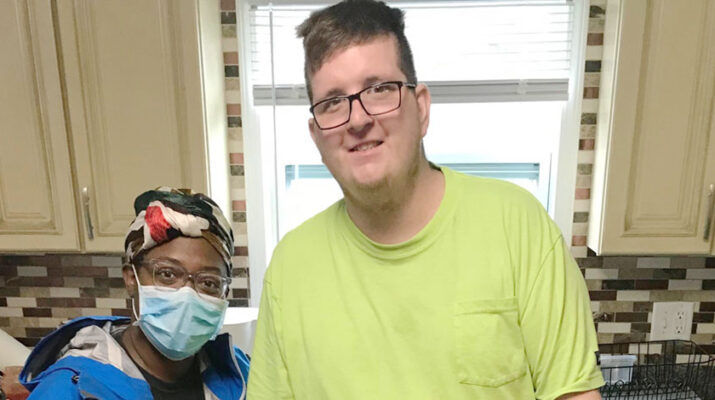By Deborah Jeanne Sergeant
A new study of 20,000 New Yorkers published in Disability and Health Journal indicates that people who have developmental disabilities and are living in group homes have more than double the rate of death than the general population.
Among those whom the Centers for Disease Control and Prevention states are at higher risk include:
• People who have limited mobility or who cannot avoid coming into close contact with others who may be infected, such as direct support providers and family members
• People who have trouble understanding information or practicing preventive measures, such as hand washing and social distancing
• People who may not be able to communicate symptoms of illness
These are true of many individuals who live in group homes for persons with developmental disabilities. The congregant nature of living in a group home, along with the continual circulation of employees who bring in outside exposure, also contribute to higher risk. Not all residents can wear masks because of health issues.
This population also tends to experience higher rates of co-morbidities that have been associated with worse COVID-19 cases, including hypertension, heart disease, respiratory disease and diabetes.
Jennifer O’Sullivan is the director of communications with New York State Office for People with Developmental Disabilities (OPWDD) in Albany.
“OPWDD has taken the threat of COVID-19 to the people we support and the broader community very seriously and all staff are fully trained on infection control practices, PPE use and quarantine protocols,” O’Sullivan said. “The agency activated our emergency response team at the onset of this public health emergency to closely monitor all reports of possible contact within our system and created a 24-hour emergency services number for providers and staff to call with any issues. We continue to monitor the needs of our providers and staff to ensure the continued health and safety of the people we support as we return to a new normal.”
Like nursing homes, group homes have many factors that increase risk, yet little attention has been given to group home residents’ risk compared with nursing home residents.
In congregant settings like group homes, residents do not have the opportunity to practice social distancing in the same way that the rest of the population can. Some may not understand the importance of hand washing and may not be capable of washing their own hands or wearing a mask.
Helio Health in Syracuse primarily serves people with substance abuse and mental health disorders. Some also have developmental disabilities.
“It’s a challenge because one of the things we’ve taught folks is that community and the sense of togetherness with others is part of your healthy supports,” said Jeremy Klemanski, president and CEO of Helio Health. “Being able to talk with a peer and being with people experiencing what you’re experiencing is part of what we teach.”
To help reduce the risk, the organization redesigned spaces by removing and rearranging furniture to promote social distancing, along with ramping up emphasis on hand washing and requiring masks.
“In our residential facility, you may take your mask off if you’re in your room alone but in a hallway or congregant setting, you have to wear it,” Klemanski said. “It’s challenging for some people but with positive reinforcement, we’ve been pretty successful. We’ve not yet had COVID spread in any of our facilities.”
Anyone coming inside must be screened. Helio Health has reduced visitation and vendors coming into the buildings. The organization operates 14 congregant treatment facilities in Central New York.
Marisa Geitner, president and CEO at Heritage Christian Services, which operates 63 group homes from Rochester to Buffalo, believes that the factor of co-morbidities is why group home residents face such a higher risk than the general population.
“Early on, we limited the amount of staff in and out of the program,” Geitner said. “The first two and a half months, we relied on a lean staff to keep the transition in and out of the program to a minimum.”
When the pandemic first started, Heritage also started a 24/7 hotline to answer questions posed by employees and residents’ family members. Heritage also developed an inventory-based system to stock and distribute essential items and signed up each group home with an Instacart account to limit exposure.
Like other such organizations, to help reduce the risk, she said that Heritage follows social distancing, masking, sanitation, and hygiene protocols as well as employee screening.
Kalet Lenart is program manager in the Day Hab Without Walls program at Community Options New York, Inc. in East Syracuse. It has been tough on individuals in the program to not do some of their regular activities and to stay home more.
“It’s challenging coming up with outdoor and at-home activities that don’t involve big crowds,” Lenart said.
For now, crafts, hiking and cooking have helped build skills and pass the time. It’s not just that participants feel bored.
“They’re used to a routine,” Lenart said. “It’s been challenging sometimes to motivate them or find an activity they can get interested in.”
Lenart credits her staff for carrying out the organization’s safety plans, which include screening, decreasing car capacity for outings, increased cleaning and wearing masks when social distancing isn’t possible. Community Options also keeps the same staff working at a house to minimize the chances of exposure.
“We have been trying to educate them,” she said of the individuals Community Options serves. “It’s constant reminders of explaining what COVID-19 is and how it can affect our lives. It’s also to be there to let them vent because it’s frustrating to them. We’re there for support.”
Photo: Latefia Armstrong and Andrew Rainess are an employee of and a resident of Community Options New York, Inc., respectively.

